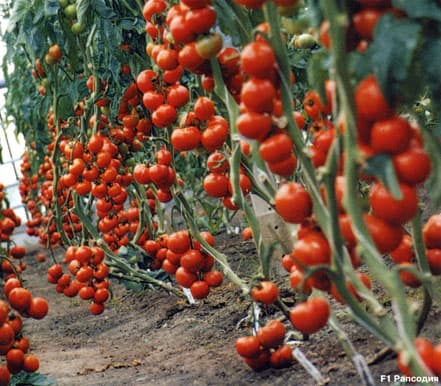An early-ripening, indeterminate hybrid variety for harvesting with brushes, highly resistant to late blight.
Period from planting seedlings to fruit ripening: 55–60 days.
The fruits are round, red, glossy, without a green spot near the stalk, weighing about 125–150 g, which are very resistant to cracking. The fruits are perfectly balanced in size.
Used fresh, for making sauces and seasonings or for canning.

These tomatoes are intended for harvesting fruits in clusters.
Cluster tomatoes have several original properties and characteristics that are often very important for gardeners.
First of all, such tomatoes will interest those who visit the garden every week or so. How happy they will be when, having arrived at their plot in 7-10 days, they find that all the red tomatoes are hanging on the plants and none of them are cracked or overripe.
Cluster tomato hybrids have fruits that are aligned in size not only within the cluster, but also within the entire plant. Each simple, two-row inflorescence of the "fish skeleton" type forms from 7 to 10 fruits.
If the fruits are supposed to be harvested in clusters, then they are standardized - only 6-8 ovaries are left on each inflorescence. This contributes to even greater alignment of the fruits and their friendly ripening.
Hybrids intended for picking in clusters necessarily contain genes that control the synchronicity of fruit ripening. If such genes were absent, the first fruits in the cluster could overripen, while the fruits in the upper part of the inflorescence would still be green. Due to these genes, the fruits of cluster tomatoes turn red at the same time and remain on the plant for a long time, without overripening or falling off.
Resistance of fruits to cracking is no less important. When harvesting, the clusters of fruits are cut off entirely, at the base, but individual harvesting is also possible.
If the fruits collected in clusters are going to be stored (and they keep well even in uncontrolled conditions), they are not separated from the stalks. The high content of pectin substances (18%) in them contributes to good preservation of the fruits.
To increase the yield and extend the storage period of the fruits, the clusters are cut off when the first 2-3 fruits turn red. In this case, the remaining fruits acquire a marketable color within the next 3-4 days. The fruits of cluster tomatoes have very high quality: they are dense, have a pleasant sweet and sour taste, with a small number of chambers, and the content of ascorbic acid in the fruits even increases during storage, which greatly increases their biological value.












